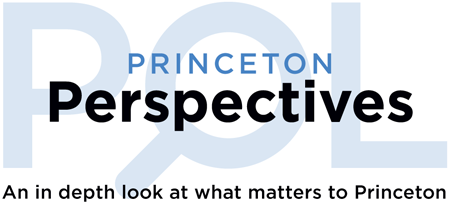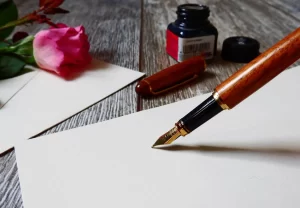 Ah! The art of a love letter! When was the last time you took out pen and paper, to share your deepest thoughts with the one you love? There is a passion that can only transcend in this form. Today, it’s likely Facetime that keeps long distance lovers connected and with the loss of cursive teachings these days, what would a love letter even look like between two paramours from Gen Z?
Ah! The art of a love letter! When was the last time you took out pen and paper, to share your deepest thoughts with the one you love? There is a passion that can only transcend in this form. Today, it’s likely Facetime that keeps long distance lovers connected and with the loss of cursive teachings these days, what would a love letter even look like between two paramours from Gen Z?
Today’s young lovebirds might use emojis or social media acronyms like ICYMI (In Case You Missed It) or YOLO (You Only Live Once) while messaging through SnapChat. While meant to be private, salvaged love notes from the past offer deep insight into the times, relationships and more. Will someone be able to access SnapChat, Instagram or even read old text messages 80 years from now? There certainly will be little stored from Facetime conversations to have an historic recording of what was being shared between two loves today. While we are always reminded of the digital trail one can leave, there is a wonder if love messages from 2025 will be accessible in the future or whether the art form is lost in the past.
The written love letter, permanently noted by hand or typed onto paper, saved and later discovered, has provided insight into loves and so much more from the past. Two such love-stories with Princeton connections were long kept secret but shared in recent years with the public through their own words, providing intimate looks into these highly recognized lovers. Meant to be burned, letters from once-Princeton local, Institute for Advanced Study’s faculty member and Nobel Prize-winning physicist Albert Einstein, share a side often not seen by the public. Additionally, the heartfelt words of Nobel Laureate poet and former unofficial artist in residence at Princeton’s Institute for Advanced Study, T.S. Eliot, provide an otherwise possibly unknown peek into his inspiration.
THE RELATIONSHIPS REVEALED
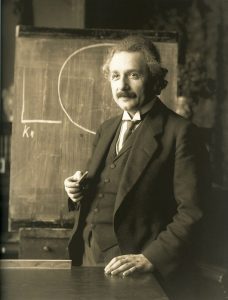 The Einstein letters, written to his lover Margarita Konenkova, reveal someone who truly cares about another, who wants to share the daily ins-and-outs of his life and spend cherished time together. Six (of many) letters were given by Konenkova to Marjorie Bishop (then her neighbor) with strict instructions, that unless claimed by 1955, Bishop had sole authority as to their disposal. Bishop even wrote a note, instructing in 1960, in the case of her death, the letter contents in the box were to be burned. But they were not. Instead, 20 years after receipt, it appears Bishop changed her mind and gave them to psychoanalyst Muriel Gardiner in 1969. She wanted them preserved and sent them the Sigmund Freud Archives for safe keeping. To do that, the archives placed them in the care of Library of Congress where, 50 years later, they were opened and today they remain.
The Einstein letters, written to his lover Margarita Konenkova, reveal someone who truly cares about another, who wants to share the daily ins-and-outs of his life and spend cherished time together. Six (of many) letters were given by Konenkova to Marjorie Bishop (then her neighbor) with strict instructions, that unless claimed by 1955, Bishop had sole authority as to their disposal. Bishop even wrote a note, instructing in 1960, in the case of her death, the letter contents in the box were to be burned. But they were not. Instead, 20 years after receipt, it appears Bishop changed her mind and gave them to psychoanalyst Muriel Gardiner in 1969. She wanted them preserved and sent them the Sigmund Freud Archives for safe keeping. To do that, the archives placed them in the care of Library of Congress where, 50 years later, they were opened and today they remain.
The 50-year span was an effort to ensure that the secret love affair, known to few, not be revealed while Einstein, Konenkova and any of their younger relatives were still alive. Why? At least partially because Konenkova was still married, though arguably quite lonely. She and Einstein met when her sculptor husband was commissioned to create a bust of Einstein. In 2019, the world was finally exposed to six never-before-seen passionate love letters from Albert Einstein to Margarita Konenkova, dating back to 1944.
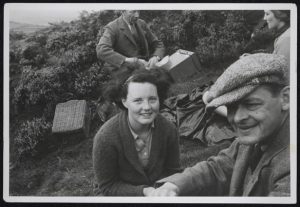
Letters written from T.S. Eliot to Emily Hale similarly share deep affection, warmth and a desire to truly know each other. The letters also faced restrictions as they were barred from release until 50 years after Eliot or Hale’s death, whichever came later. Hale passed in 1969 and in 2020 the letters were revealed at Princeton University’s Firestone Library. They were personally donated there by Hale herself. In this instance, 1,131 letters written by Eliot between 1930 and 1957 remain available for research. All correspondence back from Hale are gone, burned by Eliot, but the collection does include letters Hale wrote to others, detailing their relationship as well as including photographs and other memorabilia.
Through it all we learn Hale and Eliot met in the Boston area in 1912. She was a speech and drama teacher at Simmons, Scripps and Smith Colleges while he was a graduate student at Harvard University. They reconnected in 1922 when she visited London, and he confessed his affection towards her (he was still married but estranged. His wife suffered severe mental illness and as a strong Christian, he would not divorce her). Hale claims she did not reciprocate the feelings at that time.
“You are always with me in imagination in these ways, at night and morning and during the day, and even when I am saying these things that you cannot agree with. During these recent months I have been much tormented on your account,” Eliot wrote in a 1936 correspondence. The letters in this collection display a strong emotional relationship, that at first was mostly one-sided but later became mutual. Mostly written while Eliot was abroad in England, the contents reveal that Hale was his muse and sheds an incredible amount of light on the references and words used in Eliot’s works over the years. It was learned, in a statement to Princeton University Librarian William Dix, upon donating the letters, that it was in the mid-1930s, Hale began to reciprocate Eliot’s passion. His wife had been committed to an institution, so he spent summers visiting Hale. She reveals, in her statement, that she had hoped to marry him (once his wife passed, which happened in the mid-1940s). To the surprise of many, that did not happen. Instead of choosing his muse, in 1947 he married another woman in England and wrote no further poems.
WHAT THE LETTERS SAY
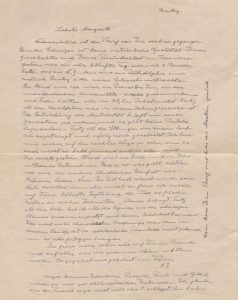
The original letters written by Einstein to Konenkova were written in his native tongue, German. A Library of Congress volunteer translated them into English, allowing the public to further review, study and feel their connection. Josh Levy, Historian of Science and Technology at Library of Congress explained along with archivist Rachel McNellis in the 2023 blog Unfolding History, Love and Intrigue at Princeton: Newly Opened Letters from Einstein’s Love Affair with Margarita Konenkova that “The letters alternate between big ideas and the human scale of everyday life. In one, Einstein expresses his excitement for Konenkova’s upcoming birthday, but also insists that ‘birthday parties are stupid bourgeois affairs.’ In another, he retreats from his disdain for birthday celebrations, noting how thrilled he was when colleagues Peter and Margot Bergmann gave him Vivaldi concerti for his own birthday – even if it meant he needed to learn to play the violin again.”
Through Einstein’s letters to Konenkova you can feel a strong love as he shares some of his deepest thoughts. He details the “Half-Nest,” an area in his home where he liked to enjoy time with Konenkova when she would visit. The letters at Firestone Library represent only a portion of those that were written. In conjunction with others stored at Konenkova Memorial Museum in Moscow and some sold in auction by Sotheby’s in 1998, there is rumor that Konenkova was more than just a loving participant and possibly a Soviet spy. In a letter written in 1945, Einstein speaks of his conversations about atomic weapons, just after Hiroshima and Nagasaki had been bombed. Nothing secretive is revealed but were these and other similar conversations leaked back to the Soviets? Researchers don’t believe so, but one may never know!
Beyond their love affair, Einstein writes about visits with brilliant minds and friends Robert Oppenheimer, Bertrand Russell, Wolfgang Pauli and Kurt Gödel. To him, it is just another day, but to the reader today it is a glimpse into a life most can’t relate to. Each note begins with “Dearest Margarita!” and ends signed, “A.E.”
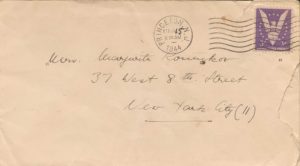
From the mundane to the emotional, here are some examples of other things Einstein shared in his letters:
January 4, 1944: “My flu is much better but not completely over yet. I think, however, that I will be able to get up tomorrow.”
Jan 31, 1944: “I am very much looking forward to your visit and everything we will experience and do together. Be greeted and kissed by your A. E.”
March 15, 1944: “As always, I was at the institute this morning and drew my scrawls onto the blackboard and Pauli was there too. I found out about some really beautiful things and that was the true and real birthday present.” He also added, “In the afternoon after the traditional sojourn in the Nest – unfortunately alone.”
Sept. 13, 1945: “I read the brochure of a colleague about the atomic bomb that triggered my honest admiration. I realize that local physicists are against keeping experiences permanently secret because they feel that this would poison the political atmosphere and might cause new war risks. All these are welcome signs, so one doesn’t have to be too pessimistic.”
In the final letter of this collection, also dated Sept. 13, 1945, Einstein implies Konenkova is torn, though of exactly what, it is not clear. He promises to be there for her, no matter her choice. “But I assure of one thing. If you will choose the hard way I will act in a way that you will not experience any pain, even if you would search with an opera-glass that can look through everything. At younger ages I could not have made such a promise because nature’s power can’t be overcome by will, at least not unpunished. But it is different with a plant in late fall, strict ruling can only be good. You can rest assured in this regard.”
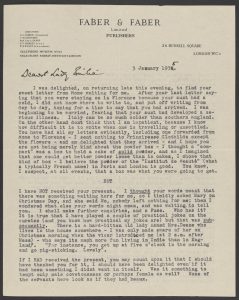
Upon studying the Eliot collection, those who know his work can note connections between the intimacy of Eliot and Hale reflected in his mid to late pieces. No one can clearly understand why Eliot chose not to marry Hale in the end, who appears to have wanted to further their relationship. But it is clear that the years in which he clamored for her affection and those they shared time together embellished his creative genius.
Before one delves into the details, it is obvious the sheer number of words and thoughts that are put into each letter are monstrous. His letters were formal and long when written on a typewriter, but sometimes when a typewriter wasn’t available, he hand-wrote shorter notes just to stay connected. Even on the typed letters, Eliot took care to handwrite her name and sign his. Much like the letters from Einstein, Eliot’s intimate thoughts are shared in combination with details of where he went, who he is seeing and what needs to be done. It can be fascinating to read his hopes and desires, from the mundane to the grand.
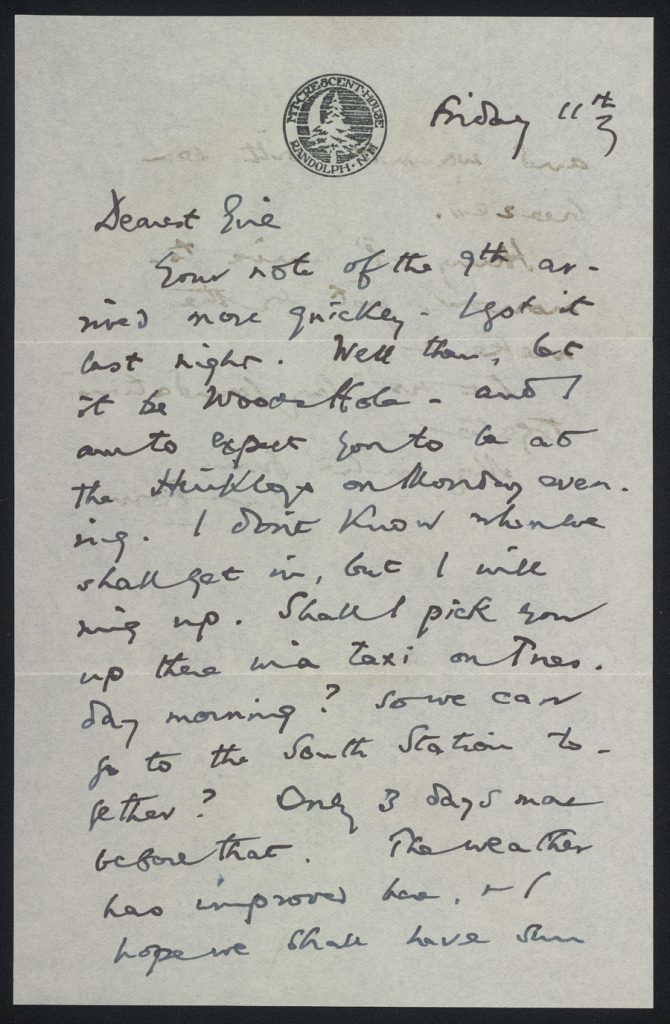
One wishes for more moments they have together, as Eliot writes often of his travels, including plans to visit Hale or have her come visit him. Some examples of other things Eliot shared in his letters include:
Aug 2, 1934: “You also know perfectly well that I would literally give my eyesight to be able to marry you. Though unworthy of such happiness. I admit that I love you more intensely and appreciatively than ever – though at no time in the past would this have seemed to me possible – and probably this process will go on. But, my love, my love, what do you think I CAN do?”
Jan. 3, 1935: “I believe it would be better for Vivienne if she could be committed to an institution, but in this country, it is very difficult to restrain anyone’s liberty…I should think that eventually she was bound to get into financial difficulties.”
Nov. 4, 1938: “It always pains me to think of much greater advantages I have than you in the way of daily life: it is only the problem of how to get a restful holiday that seems equally insoluble for both of us. That, however, makes the arrangement of your winters all the more important. How I wish I could look after both for you! But this is a thought so poignant that I do not allow my mind to dwell on it – yet it is perhaps a good thing to express it now and then.”
Jan. 11, 1951: “I have been trying to work out a provisional scheme for a play, and to settle on my characters and their relations enough to sketch a few scenes. But success with one play does not seem to increase my confidence in approaching another, but rather the contrary…”
HOW TO READ MORE
There is so much said between the couples through the years of correspondence, we don’t have time or space to get into it all. But it is clear they both had strong relationships, often yearned for each other and were true confidants.
If you want to read more, the letters from T.S. Eliot are available for viewing at the Special Collections Reading Room inside Princeton University’s Firestone Library. They are available to anyone that has a school or government issued ID. More detailed information on how to register and request the materials for viewing in person can be found here, on the Princeton University Library website. You can also request digital access to the Emily Hale Letters from T.S. Eliot (C0686) by creating a guest Special Collections Research Account that will provide access to navigate through the selected letters which have been digitized.
To get a closer look at six of the letters Einstein wrote to Konenkova, you can also go in person and see them at Library of Congress in Washington DC. Simply request this collection at the reference desk in the Manuscript Division. If not local, you can contact them for digital versions.
And thank goodness for such digitization! With SnapChat as the dominant means of communication for young lovebirds today, it is unlikely much will be salvaged to share anything about today’s hot, secret love affairs with future generations. It is a deep contrast to the detailed love letters by Einstein and Eliot! Luckily, the advancements in technology allow archivists to store the old letters for years to come, storing them digitally as well, so hopefully they will continue to be available 80 years from now for the romantic that seeks to read them.
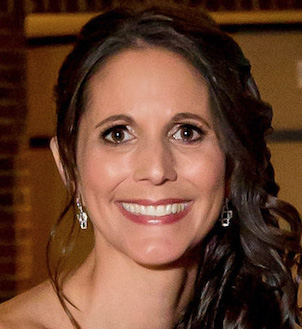
Lisa Jacknow spent years working in national and local news in and around New York City before moving to Princeton. Working as both a TV producer and news reporter, Lisa came to this area to focus on the local news of Mercer County at WZBN-TV. In recent years, she got immersed in the Princeton community by serving leadership roles at local schools in addition to volunteering for other local non-profits. In her free time, Lisa loves to spend time with her family, play tennis, sing and play the piano. A graduate of the S. I. Newhouse School of Public Communications at Syracuse University, Lisa was raised just north of Boston, Massachusetts but has lived in the tri-state area since college. She is excited to be Editor and head writer for Princeton Perspectives!
